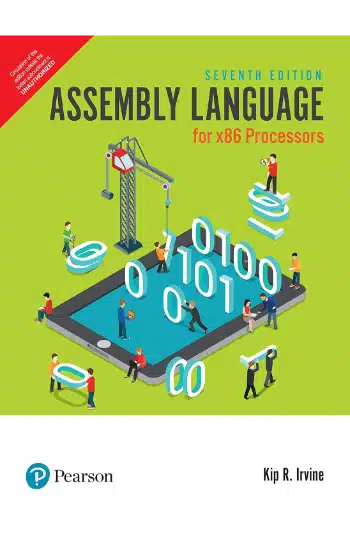
Save: 10%

Save: 10%
ASSEMBLY LANGUAGE FOR X86 PROCESSORS
Publisher:
| Author:
| Language:
| Format:
Publisher:
Author:
Language:
Format:
₹935 ₹795
Save: 15%
In stock
Ships within:
In stock
ISBN:
Page Extent:
Assembly Language for x86 Processors, 7e is suitable for undergraduate courses in assembly language programming and introductory courses in computer systems and computer architecture. Proficiency in one other programming language, preferably Java, C, or C++, is recommended. Written specifically for 32- and 64-bit Intel/Windows platform, this complete and fully Updated study of assembly language teaches students to write and debug programs at the machine level. This text simplifies and demystifies concepts that students need to grasp before they can go on to more advanced computer architecture and operating systems courses. Students put theory into practice through writing software at the machine level, creating a memorable experience that gives them the confidence to work in any OS/machine-oriented environment.Features New! Protected mode programming is entirely the focus of the printed Chapters (1 through 13). This edition uses the x86 and x86-64 processor types, explaining the differences between instruction operands and basic architecture differences.Students create applications that take full advantage of 32-bit and 64-bit processors, using protected mode and flat memory addressing. This also allows students to create Microsoft® Windows applications.16-bit programming is still covered, using Chapters from the previous edition, supplied electronically from the Pearson supplements website.Updated: There is far less dependency on the author’s subroutine libraries in this edition. Students are encouraged to call system functions themselves and use the Visual Studio debugger to step through the programs. The Irvine32 and Irvine64 libraries are available to help students handle input/output, but their use is not required.Updated: This edition features increased use of supplementary explanations of short program examples, particularly in the first 5 Chapters.Review exercises aid students in their comprehension skills. Answers to questions are included for instructors to use in test material.Updated: New programming exercises have been added, others removed, and a few existing exercises were modified. Programming exercises with solutions give students first-hand experience in writing software and allow them to immediately check their results.Updated: Review questions and exercises have been moved from the middle of the Chapter to the end of Chapters, and divided into two sections:
(1) Short answer questions, and
(2) Algorithm workbench exercises. The latter exercises require the student to write a short amount of code to accomplish a goal.
New: Each Chapter now has a Key Terms section, listing New terms and concepts, as well as New MASM directives and Intel instructions.Optional Chapter topics are offered in the final Chapters. This Chapter flexibility allows instructors to cover these Chapters in varying order and depth.New: Early Chapters now include short sections that feature 64-bit CPU architecture and programming, and we have created a 64-bit version of the book’s subroutine library named Irvine64.Updated: Students can program in either 32-bit or 64-bit mode.Updated: Legacy Chapters on 16-bit programming are provided electronically through the Pearson supplements website. Table of Contents
Assembly Language for x86 Processors, 7e is suitable for undergraduate courses in assembly language programming and introductory courses in computer systems and computer architecture. Proficiency in one other programming language, preferably Java, C, or C++, is recommended. Written specifically for 32- and 64-bit Intel/Windows platform, this complete and fully Updated study of assembly language teaches students to write and debug programs at the machine level. This text simplifies and demystifies concepts that students need to grasp before they can go on to more advanced computer architecture and operating systems courses. Students put theory into practice through writing software at the machine level, creating a memorable experience that gives them the confidence to work in any OS/machine-oriented environment.Features New! Protected mode programming is entirely the focus of the printed Chapters (1 through 13). This edition uses the x86 and x86-64 processor types, explaining the differences between instruction operands and basic architecture differences.Students create applications that take full advantage of 32-bit and 64-bit processors, using protected mode and flat memory addressing. This also allows students to create Microsoft® Windows applications.16-bit programming is still covered, using Chapters from the previous edition, supplied electronically from the Pearson supplements website.Updated: There is far less dependency on the author’s subroutine libraries in this edition. Students are encouraged to call system functions themselves and use the Visual Studio debugger to step through the programs. The Irvine32 and Irvine64 libraries are available to help students handle input/output, but their use is not required.Updated: This edition features increased use of supplementary explanations of short program examples, particularly in the first 5 Chapters.Review exercises aid students in their comprehension skills. Answers to questions are included for instructors to use in test material.Updated: New programming exercises have been added, others removed, and a few existing exercises were modified. Programming exercises with solutions give students first-hand experience in writing software and allow them to immediately check their results.Updated: Review questions and exercises have been moved from the middle of the Chapter to the end of Chapters, and divided into two sections:
(1) Short answer questions, and
(2) Algorithm workbench exercises. The latter exercises require the student to write a short amount of code to accomplish a goal.
New: Each Chapter now has a Key Terms section, listing New terms and concepts, as well as New MASM directives and Intel instructions.Optional Chapter topics are offered in the final Chapters. This Chapter flexibility allows instructors to cover these Chapters in varying order and depth.New: Early Chapters now include short sections that feature 64-bit CPU architecture and programming, and we have created a 64-bit version of the book’s subroutine library named Irvine64.Updated: Students can program in either 32-bit or 64-bit mode.Updated: Legacy Chapters on 16-bit programming are provided electronically through the Pearson supplements website. Table of Contents
About Author
Reviews
There are no reviews yet.
Related products
RELATED PRODUCTS
Physics Set Of 2 Books: Vol.1 And Vol. 2
Save: 25%
VEDIC BELIEFS AND PRACTICES THROUGH ARTHAVADA (Set of 2 Vols.)
Save: 15%



Reviews
There are no reviews yet.